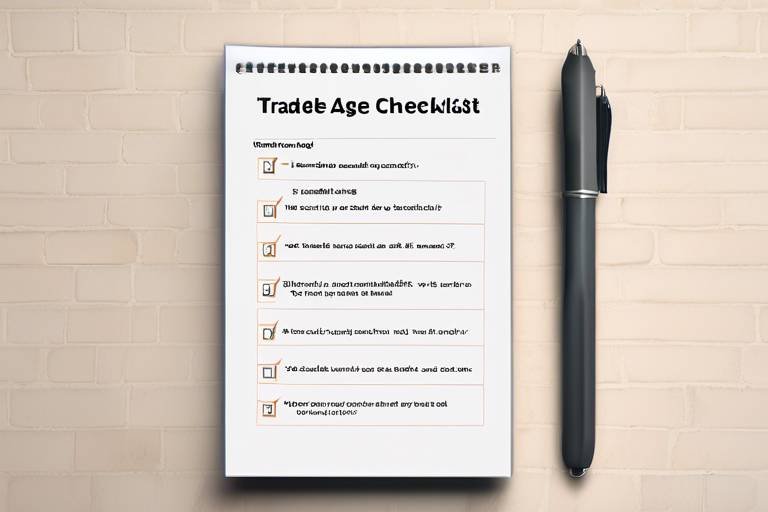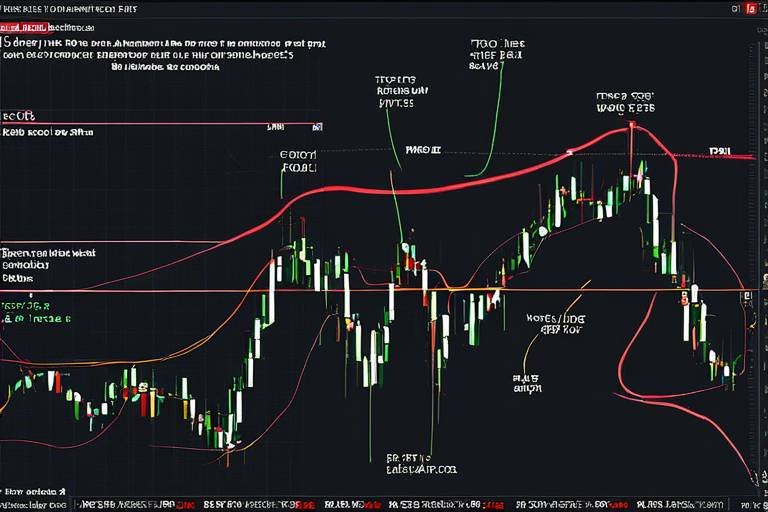Identifying False Breakouts in Trading
In the ever-evolving world of trading, one of the most perplexing phenomena that traders encounter is the false breakout. This concept can often lead to confusion and frustration, especially for those who are still finding their footing in the market. But what exactly is a false breakout, and why is it important to understand? Essentially, a false breakout occurs when the price of an asset temporarily breaches a defined support or resistance level, only to swiftly reverse direction. This can leave traders feeling like they’ve been caught in a whirlwind, making decisions based on what they thought was a solid breakout, only to realize moments later that it was a mirage. Understanding how to identify these false breakouts is crucial for making informed trading decisions and avoiding unnecessary losses.
Before diving deeper into false breakouts, let's first grasp the essence of breakouts themselves. A breakout is a term that describes the moment when the price of an asset moves beyond a predefined support or resistance level. Think of it like a runner breaking through the finish line tape; it's a clear signal that something significant is happening. For traders, recognizing these moments can be incredibly lucrative, as they often precede substantial price movements. However, without a solid understanding of what constitutes a genuine breakout versus a false one, traders may find themselves on the wrong side of a trade.
A false breakout can be likened to a mirage in the desert; it appears promising at first glance but quickly dissipates, leaving one feeling deceived. These occurrences happen when the price temporarily breaches a support or resistance level, leading traders to believe that a new trend is forming. However, just as quickly, the price reverses, often catching traders off guard. Recognizing these scenarios can prevent costly mistakes that can arise from jumping into trades too hastily. By developing a keen eye for spotting false breakouts, traders can safeguard their investments and maintain a more disciplined approach in their trading strategies.
False breakouts often exhibit distinct characteristics that can help traders differentiate between genuine and misleading signals. Some common traits include:
- Low Volume: When a breakout occurs with low trading volume, it often signifies a lack of conviction behind the move.
- Rapid Price Reversal: A quick reversal after a breakout can indicate that the price action was not supported by strong market sentiment.
- Failure to Hold Levels: If the price fails to hold above or below the breakout level after a short period, it may suggest a false breakout.
By being aware of these characteristics, traders can better assess the likelihood of a breakout being genuine or false, allowing them to make more informed decisions.
Volume analysis is a critical tool in a trader's arsenal. It provides insights into the strength of a breakout. A lack of significant volume during a breakout typically indicates a higher chance of it being false. Imagine trying to push a car uphill; if you don’t have enough force (or volume, in trading terms), the car won’t make it to the top. Similarly, without adequate volume, a price movement is less likely to sustain itself. Therefore, paying attention to volume can be the difference between a successful trade and a frustrating loss.
Another essential aspect of identifying false breakouts is closely observing price action around breakout levels. Candlestick patterns can be particularly revealing. For instance, if a breakout is accompanied by a bearish engulfing pattern or a shooting star, it can serve as a warning sign that the breakout may not hold. Just like reading the mood in a room, traders must learn to interpret the signals that price action provides. By honing this skill, traders can enhance their ability to discern between valid breakouts and those that are likely to fizzle out.
Understanding the reasons behind false breakouts can also prove beneficial. Some common causes include:
- Market News: Unexpected news can lead to sudden price movements, often resulting in false breakouts.
- Trader Psychology: The emotional responses of traders can create erratic price movements that lead to false breakouts.
- Liquidity Issues: In markets with low liquidity, even small trades can cause significant price fluctuations, leading to false signals.
By being aware of these factors, traders can better anticipate potential false breakouts and adjust their strategies accordingly.
Employing specific strategies can significantly enhance a trader's ability to spot false breakouts. One effective approach is to use technical indicators. Indicators like the Relative Strength Index (RSI) or moving averages can provide additional context to confirm breakouts. For example, if the RSI indicates overbought conditions during a breakout, it may signal that the move is unsustainable.
Incorporating technical indicators into trading strategies can be a game-changer. These tools help traders gauge market momentum and trend strength, allowing them to make more informed decisions. For instance, a moving average crossover can signal a potential breakout, while an RSI reading above 70 might suggest that the asset is overbought, hinting at a possible false breakout. By using these indicators, traders can add a layer of confirmation to their trades, reducing the likelihood of falling victim to false breakouts.
Another crucial strategy is the implementation of stop-loss orders. Knowing when and where to place these orders is vital for risk management. A well-placed stop-loss can protect traders from significant losses during false breakouts. Think of it as a safety net; it might not prevent you from falling, but it can cushion the impact. By strategically setting stop-loss orders just below support levels or above resistance levels, traders can mitigate risks effectively.
Q: What is the best way to avoid false breakouts?
A: The best way to avoid false breakouts is to combine multiple analysis techniques, such as volume analysis, price action signals, and technical indicators. This multi-faceted approach helps confirm the validity of a breakout.
Q: How can I tell if a breakout is genuine?
A: A genuine breakout is usually accompanied by strong volume, clear price action signals, and confirmation from technical indicators. If these elements align, the breakout is more likely to be valid.
Q: Are false breakouts common in all markets?
A: Yes, false breakouts can occur in any market, but they may be more prevalent in volatile or less liquid markets where price movements can be exaggerated.

Understanding Breakouts
This article explores the concept of false breakouts in trading, their implications, and strategies to identify and avoid them for more effective trading decisions.
Breakouts are pivotal moments in trading that can make or break a trader's strategy. Essentially, a breakout occurs when the price of an asset moves beyond a defined support or resistance level. Picture this: a rubber band stretched to its limit. When it finally snaps, it can either fly forward or fall back. Similarly, when price levels are breached, traders often anticipate a significant price movement, creating opportunities for profit. However, understanding the mechanics of breakouts is essential for traders to capitalize on potential price movements effectively.
To fully grasp the concept of breakouts, one must consider the two main types: bullish breakouts and bearish breakouts. A bullish breakout occurs when the price breaks above a resistance level, signaling potential upward momentum, while a bearish breakout happens when the price falls below a support level, indicating possible downward trends. Recognizing these scenarios is crucial, as they can lead to significant trading opportunities.
Moreover, the context surrounding a breakout is equally important. Traders should always analyze the market conditions leading to the breakout. For instance, a breakout accompanied by strong volume and positive news can be seen as more reliable compared to one that occurs in a stagnant market with low trading activity. This is where the concept of market sentiment comes into play. A trader's perception of the market can greatly influence their decisions, and understanding this sentiment can provide valuable insights into the likelihood of a breakout sustaining its momentum.
Let’s not forget the importance of timing. Breakouts can happen at any moment, but they often occur during periods of high volatility or after significant news announcements. This is why traders must stay alert and be ready to act quickly. Utilizing tools such as technical analysis and real-time data can help traders identify potential breakout opportunities before they happen.
In summary, understanding breakouts is not just about recognizing price movements; it’s about interpreting the underlying factors that contribute to these movements. By keeping an eye on market conditions, volume, and sentiment, traders can position themselves to take advantage of breakouts while minimizing risks associated with false signals.
A false breakout happens when the price temporarily moves past a support or resistance level but quickly reverses. Recognizing these scenarios can prevent traders from making costly mistakes.
False breakouts often exhibit specific characteristics, such as low volume or rapid price reversals. Identifying these traits can help traders distinguish between genuine breakouts and false signals.
Analyzing volume during a breakout can provide insights. A lack of significant volume typically indicates a higher chance of a false breakout, signaling traders to be cautious.
Observing price action around breakout levels is crucial. Candlestick patterns and price behavior can reveal whether a breakout is likely to be valid or false.
Understanding the reasons behind false breakouts can help traders anticipate them. Factors such as market news, trader psychology, and liquidity can all play significant roles.
Employing specific strategies can enhance a trader's ability to spot false breakouts. These techniques include using technical indicators and setting appropriate stop-loss orders.
Utilizing indicators like RSI or moving averages can help traders confirm breakouts. These tools can provide additional context to determine the validity of price movements.
Implementing stop-loss orders strategically can protect traders from losses during false breakouts. Knowing when and where to place these orders is crucial for risk management.
Q: What is a breakout in trading?
A: A breakout in trading occurs when the price moves beyond a defined support or resistance level, indicating potential future price movements.
Q: How can I identify a false breakout?
A: Look for characteristics such as low trading volume, rapid price reversals, and lack of confirmation from technical indicators.
Q: Why do false breakouts happen?
A: False breakouts can occur due to market news, trader psychology, and liquidity issues, causing temporary price movements that quickly reverse.
Q: What strategies can I use to avoid false breakouts?
A: Use technical indicators for confirmation, analyze volume, and set appropriate stop-loss orders to manage risk effectively.

What is a False Breakout?
A false breakout is a term that traders often dread, as it can lead to significant losses if not identified promptly. Essentially, a false breakout occurs when the price of an asset moves beyond a defined support or resistance level, only to reverse direction shortly thereafter. Imagine standing at the edge of a cliff: you see the horizon beyond, but one wrong step, and you tumble back down. This scenario perfectly illustrates the risk of false breakouts in trading.
To grasp the implications of false breakouts, it's crucial to understand their mechanics. When the price breaks through a resistance level, traders often interpret this as a signal to buy, anticipating further upward movement. Conversely, if the price falls below a support level, it may trigger selling actions. However, if the move is merely a fleeting spike, the price will quickly revert, catching many traders off guard. This reversal can create a sense of urgency, leading to hasty decisions that compound losses.
So, what causes these deceptive movements? There are several factors at play. For one, market sentiment can shift rapidly due to unexpected news or events, causing prices to spike. Additionally, trader psychology plays a significant role; fear and greed can drive irrational behavior, leading to false breakouts. Furthermore, liquidity—or the lack thereof—can exacerbate these situations. In less liquid markets, even a small number of trades can significantly impact the price, leading to false signals.
Recognizing a false breakout is like spotting a mirage in the desert; it requires keen observation and analysis. Traders should always look beyond the initial price movement. Key indicators to consider include volume and price action. A breakout accompanied by low volume is often a red flag, suggesting that the move may not have the backing of genuine market interest. Similarly, analyzing price patterns can provide insights into whether a breakout is sustainable or merely a fleeting moment.
In summary, understanding false breakouts is vital for any trader looking to navigate the financial markets effectively. By recognizing the signs and employing strategies to mitigate risks, traders can protect their investments and make more informed decisions. Remember, in the world of trading, it’s not just about making the right moves, but also about knowing when to hold back and avoid the pitfalls of false signals.

Characteristics of False Breakouts
False breakouts can be frustrating for traders, often leading to unnecessary losses and missed opportunities. To effectively navigate this tricky terrain, it's essential to recognize the key characteristics that typically accompany these deceptive market movements. One of the primary indicators of a false breakout is low trading volume. When a price breaches a support or resistance level but does so with minimal volume, it signals a lack of conviction among traders. Think of it like a crowd cheering for a team that’s just scored, but then quickly dispersing when it becomes clear that the goal was offside. This lack of enthusiasm can often lead to a swift price reversal.
Another characteristic to look out for is the speed of the reversal. If the price quickly retreats back below a resistance level or above a support level, it could be a sign that the breakout was not genuine. For instance, imagine a sprinter who bursts off the starting blocks only to trip and fall moments later; this sudden change in direction can be a clear indication that the initial movement was not sustainable. Furthermore, traders should pay close attention to candlestick patterns that form during these breakouts. Patterns such as doji or inverted hammer can indicate indecision in the market, suggesting that the breakout may lack strength.
Moreover, market sentiment plays a crucial role in determining the legitimacy of a breakout. If the overall market sentiment is bearish, yet a stock breaks out to the upside, it raises a red flag. It’s like seeing a lone wolf trying to lead a pack of sheep; it’s likely to fail. Traders should also consider the broader market context, including news events or economic reports that could affect price movements. If a breakout occurs during a period of high volatility due to unexpected news, it may not hold, leading to a false breakout.
In summary, recognizing these characteristics can significantly enhance a trader's ability to identify false breakouts. By combining volume analysis, observing the speed of price reversals, and understanding market sentiment, traders can better navigate the complexities of the trading landscape. Remember, in trading, as in life, not everything is as it seems, so staying alert and informed is key!
- What is a breakout in trading? A breakout occurs when the price moves beyond a defined support or resistance level, signaling a potential price movement.
- How can I identify a false breakout? Look for low trading volume, rapid price reversals, and certain candlestick patterns that indicate indecision.
- What should I do if I suspect a false breakout? It's important to be cautious; consider waiting for confirmation from other indicators before making a trade.
- Can false breakouts be avoided entirely? While they can't be completely avoided, using strategies like volume analysis and technical indicators can help minimize their impact.

Volume Analysis
When it comes to trading, is like the heartbeat of the market. It tells you how many shares or contracts are being traded during a specific period and can be a powerful indicator of market sentiment. Understanding volume can help you differentiate between a genuine breakout and a false one. Imagine you're at a concert; if the crowd is roaring and jumping, you know the band is hitting the right notes. Conversely, if only a few people are clapping, you might wonder if the performance is lackluster. Similarly, in trading, a breakout accompanied by high volume is like that roaring crowd—it suggests strong conviction among traders.
So, how do you analyze volume effectively? First, you need to observe the volume trends during a breakout. A significant increase in volume can indicate that the price movement is supported by strong interest, making it more likely to be a valid breakout. On the other hand, if the price breaks through a resistance level with low volume, it could be a sign that the breakout is weak and may reverse shortly. In essence, volume acts as a confirmation tool.
To illustrate this further, consider the following table that outlines the relationship between volume and breakout validity:
| Volume Condition | Implication | Action |
|---|---|---|
| High Volume | Strong conviction in the breakout | Consider entering a trade |
| Low Volume | Weak breakout signal | Exercise caution; consider waiting |
| Volume Spike | Potential trend reversal | Reassess your position |
In addition to analyzing volume trends, it's also crucial to compare current volume levels with historical averages. If the volume during a breakout is significantly higher than the average volume over the past few days or weeks, it strengthens the case for the breakout being genuine. Conversely, if the volume is below average, it raises a red flag. This comparison can be likened to comparing your current workout performance with your past records; if you’re lifting weights significantly more than usual, it’s likely you’re on the right track. But if you’re struggling to match your previous efforts, it might be time to reassess your strategy.
Ultimately, volume analysis is an essential tool in your trading toolkit. By paying close attention to volume during breakouts, you can make more informed decisions and avoid the pitfalls of false breakouts. Remember, trading isn't just about following price movements; it's about understanding the underlying forces that drive those movements. With a solid grasp of volume analysis, you'll be better equipped to navigate the unpredictable waters of the market.

Price Action Signals
When it comes to trading, price action serves as a vital barometer for gauging market sentiment and potential future movements. Unlike traditional indicators that rely on complex calculations, price action is all about interpreting the raw movements of price over time. By focusing on these movements, traders can gain insights into whether a breakout is likely to hold or merely a fleeting moment of excitement. Have you ever watched a movie where the plot twists keep you on the edge of your seat? That’s how price action can feel—full of suspense and surprises!
One of the most effective ways to analyze price action is through candlestick patterns. These patterns can tell you a lot about market psychology. For instance, a series of bullish candlesticks following a breakout may suggest strong buying interest, while a sudden appearance of bearish candlesticks could indicate that the momentum is fading. Familiarizing yourself with common patterns, such as the Doji, Hammer, and Engulfing, can be incredibly beneficial. Each of these patterns provides clues that help traders decide whether to jump in or hold back.
Additionally, observing the context in which these patterns occur is crucial. For example, if a breakout happens with a significant price increase but is followed by a rapid reversal, it could be a warning sign. This scenario often indicates that traders are not convinced about the breakout’s legitimacy. Think of it like a rollercoaster ride; just because you go up doesn’t mean you won’t come crashing down!
Moreover, traders should pay attention to the support and resistance levels that are being tested during these breakouts. If the price approaches a resistance level but fails to break through, it often leads to a false breakout. Conversely, if the price breaks through a resistance level with strong momentum and then retraces back below it, that’s another red flag. To illustrate this, consider the following table that summarizes key price action signals to watch for during breakouts:
| Price Action Signal | Implication |
|---|---|
| Strong Bullish Candlestick | Potential Valid Breakout |
| Weak Bearish Candlestick | Possible False Breakout |
| Volume Spike on Breakout | Increased Validity |
| Quick Reversal after Breakout | High Risk of False Breakout |
In conclusion, mastering price action signals is like learning to read the subtle cues in a conversation. It requires practice, patience, and a keen eye for detail. By paying close attention to candlestick patterns, market context, and support/resistance dynamics, traders can significantly improve their chances of identifying genuine breakouts versus false ones. Remember, the market is often unpredictable, but with the right tools and knowledge, you can navigate its twists and turns more effectively.
- What is a false breakout? A false breakout occurs when the price temporarily moves beyond a support or resistance level but quickly reverses, misleading traders.
- How can I identify a false breakout? Look for low trading volume, rapid price reversals, and certain candlestick patterns that indicate a lack of conviction in the breakout.
- Are there specific indicators to help identify false breakouts? Yes, indicators like the Relative Strength Index (RSI) and Moving Averages can provide insights into market momentum and strength.
- What role do stop-loss orders play in managing false breakouts? Setting stop-loss orders can help limit potential losses if the market reverses unexpectedly after a breakout.

Common Causes of False Breakouts
Understanding the is crucial for any trader looking to sharpen their skills and enhance their decision-making process. False breakouts can occur due to a variety of factors, and recognizing these can help traders avoid costly mistakes. One of the primary causes stems from market news. When unexpected news breaks, it can lead to rapid price movements that momentarily push the price beyond established support or resistance levels. However, once the initial reaction subsides, the price often retraces back, creating a false breakout scenario.
Another significant factor is trader psychology. Traders often react emotionally to market movements, leading to impulsive decisions. When a breakout occurs, many traders rush to enter positions, driven by the fear of missing out (FOMO). This rush can create a temporary surge in volume, but if the breakout isn't supported by solid fundamentals, the price may quickly reverse, trapping those who acted on emotion rather than analysis.
Liquidity also plays a vital role in the occurrence of false breakouts. In markets with low liquidity, even small orders can significantly impact price movements. This can lead to sudden spikes that breach resistance or support levels, only to be followed by a swift return to previous price levels once the orders are filled. Traders should be particularly cautious during these times, as the lack of liquidity can create an environment ripe for false signals.
Additionally, market manipulation can lead to false breakouts. In some cases, larger players in the market may intentionally push the price past a key level to trigger stop-loss orders or create panic among retail traders. Once these orders are executed, the price may revert back, leaving many traders caught in a losing position. Understanding these manipulative tactics can provide traders with a significant edge in identifying potential false breakouts.
Lastly, it's essential to consider the overall market trend. If the broader market is in a strong trend, false breakouts may be less common. Conversely, in a choppy or sideways market, the likelihood of encountering false breakouts increases. Traders should always keep the larger market context in mind when analyzing breakout scenarios.
- What is the best way to avoid false breakouts?
To avoid false breakouts, traders should combine technical analysis with fundamental insights. Using volume analysis, candlestick patterns, and market news can help provide a clearer picture.
- Are false breakouts always bad?
Not necessarily. While they can lead to losses, identifying false breakouts can also present opportunities for traders who are quick and adept at entering positions in the opposite direction.
- How do I know if a breakout is valid?
A valid breakout is typically confirmed by significant volume and sustained price movement beyond key levels. Monitoring price action closely post-breakout is essential.

Strategies to Identify False Breakouts
Identifying false breakouts is a crucial skill for any trader looking to navigate the often tumultuous waters of financial markets. It's like trying to spot a mirage in the desert; it takes practice and a keen eye. One of the most effective ways to enhance your ability to spot these deceptive price movements is by employing a variety of strategies that can provide clarity amidst the chaos. By combining different technical tools and market analysis techniques, traders can significantly improve their chances of distinguishing between genuine breakouts and false signals.
One of the first strategies involves the use of technical indicators. These tools can serve as your trusty compass when navigating the tricky terrain of price action. For instance, the Relative Strength Index (RSI) is a popular momentum oscillator that can help traders gauge whether an asset is overbought or oversold. If a breakout occurs while the RSI indicates that the asset is overbought, it might be a red flag, suggesting that the breakout could be false. Similarly, moving averages can provide context; a breakout above a moving average that is trending downwards might not hold for long, signaling the potential for a false breakout.
Another vital strategy is to focus on volume analysis. Volume is like the heartbeat of the market; it tells you how strong a price movement is. When analyzing breakouts, pay close attention to the volume accompanying the price movement. A breakout that occurs with low volume is often suspect. Think of it this way: if a crowd is cheering for a team but only a handful of fans are in the stands, the excitement may not be genuine. Therefore, a significant increase in volume during a breakout can be a reassuring sign that the move is legitimate, while low volume may indicate a false breakout.
Additionally, observing price action signals can provide invaluable insights. Candlestick patterns, for example, can reveal a lot about market sentiment. A single bullish candle breaking a resistance level might seem promising, but if it’s followed by a bearish engulfing pattern, it could signal a reversal and hint at a false breakout. Traders should also consider the overall market context; if broader market conditions are bearish, a breakout in a specific asset may not hold. This is where the concept of confluence comes into play—when multiple factors align, the chances of a successful breakout increase.
Setting stop-loss orders strategically is another essential strategy. A stop-loss order acts as a safety net, protecting traders from significant losses during market fluctuations. When entering a trade based on a breakout, consider placing your stop-loss just below the breakout level. This way, if the price does reverse and a false breakout occurs, your losses will be minimized. However, it’s also important to avoid placing stop-loss orders too close to the breakout level, as this could lead to being stopped out prematurely during normal market noise.
In summary, identifying false breakouts requires a mix of analytical skills and market intuition. By leveraging technical indicators, analyzing volume, observing price action signals, and employing strategic stop-loss orders, traders can significantly reduce their risk and improve their trading outcomes. Remember, the goal is not just to react to price movements but to understand the underlying market dynamics that drive these changes. With practice and attention to detail, you can become adept at spotting false breakouts and turning potential pitfalls into profitable opportunities.
- What is a false breakout? A false breakout occurs when the price temporarily moves beyond a defined support or resistance level but quickly reverses, leading to potential losses for traders who acted on the initial breakout.
- How can I identify a false breakout? Look for low trading volume, rapid price reversals, and unfavorable candlestick patterns around breakout levels to help identify false breakouts.
- What indicators are best for spotting false breakouts? Common indicators include the Relative Strength Index (RSI) and moving averages, which can provide context for price movements.
- Should I always use stop-loss orders? Yes, using stop-loss orders is a prudent risk management strategy to protect against significant losses during false breakouts.

Technical Indicators
When it comes to trading, relying solely on gut feelings or market rumors can be a recipe for disaster. This is where come into play, acting as a trader's compass in the turbulent seas of the market. These indicators are mathematical calculations based on the price, volume, or open interest of a security, and they help traders make informed decisions. By interpreting these signals correctly, traders can significantly enhance their ability to identify genuine breakouts and avoid the pitfalls of false ones.
One of the most popular technical indicators is the Relative Strength Index (RSI). This momentum oscillator measures the speed and change of price movements, providing insights into whether a security is overbought or oversold. For instance, an RSI above 70 typically indicates that a security may be overbought, suggesting that a reversal could be imminent. Conversely, an RSI below 30 signals that a security might be oversold, potentially indicating a buying opportunity. By integrating RSI into your trading strategy, you can gauge the strength of a breakout and assess whether it is likely to hold or fizzle out.
Another key indicator is the Moving Average Convergence Divergence (MACD). This tool helps traders identify changes in the strength, direction, momentum, and duration of a trend. When the MACD line crosses above the signal line, it can be a bullish signal, indicating that a breakout might be genuine. On the other hand, if the MACD line crosses below the signal line, it may suggest that a false breakout is in play. Utilizing MACD alongside price action can provide a more comprehensive view of market dynamics.
It's also essential to consider volume analysis when using technical indicators. Volume can confirm the strength of a breakout; a breakout accompanied by high volume is more likely to be valid than one with low volume. For example, if a stock breaks through a resistance level with a surge in volume, it indicates strong buyer interest, reinforcing the legitimacy of the breakout. Conversely, if a breakout occurs with minimal volume, it raises the red flag of a potential false breakout.
Incorporating these technical indicators into your trading strategy requires practice and patience. Here are some tips to effectively use them:
- Combine multiple indicators to create a more robust trading signal.
- Always consider the broader market context; no indicator is foolproof.
- Backtest your strategies to see how they would have performed in the past.
- Stay updated on market news, as external factors can influence indicator effectiveness.
In conclusion, technical indicators are invaluable tools in a trader's arsenal. By understanding how to interpret these indicators, you can make more informed decisions, increasing your chances of spotting genuine breakouts while steering clear of false ones. Remember, the market is a complex beast, and the more tools you have at your disposal, the better equipped you'll be to navigate its challenges.
Q: What are technical indicators?
A: Technical indicators are mathematical calculations based on price, volume, or open interest, used to forecast future price movements.
Q: How can I use RSI effectively?
A: RSI can help identify overbought or oversold conditions, allowing traders to make more informed decisions about potential reversals.
Q: Why is volume important in trading?
A: Volume indicates the strength of a price movement; high volume during a breakout suggests legitimacy, while low volume raises red flags.

Setting Stop-Loss Orders
When it comes to trading, one of the most critical aspects of risk management is the stop-loss order. This is essentially your safety net in the unpredictable world of trading, designed to limit potential losses. Imagine you're on a roller coaster; just as you wouldn’t want to fly off the tracks, you don’t want your investments to plummet without a plan. A stop-loss order allows you to set a predetermined price at which your position will automatically close, helping you avoid emotional decision-making during those nail-biting market swings.
Now, you might be wondering, "How do I know where to set my stop-loss?" This can be a tricky question, but there are some general guidelines that can help. A common practice is to set your stop-loss just below a support level for long positions, or just above a resistance level for short positions. This way, you give your trade a little breathing room while still protecting yourself from significant losses. However, it's crucial to remember that every trader's strategy may differ based on their risk tolerance and trading style.
Additionally, the placement of stop-loss orders can be influenced by various factors, including the volatility of the asset you are trading. For instance, if you're trading a stock that tends to have wild price swings, you might want to set your stop-loss further away from your entry point to avoid being stopped out prematurely due to normal market fluctuations. On the flip side, if you’re trading a more stable asset, a tighter stop-loss might be more appropriate.
To illustrate this concept, let’s take a look at a simple table that outlines different scenarios for setting stop-loss orders:
| Market Condition | Stop-Loss Placement | Rationale |
|---|---|---|
| High Volatility | Further from Entry | To avoid being stopped out by normal fluctuations |
| Low Volatility | Tighter to Entry | To protect against sudden price drops |
| Near Support Level | Below Support | To allow for minor pullbacks while protecting capital |
| Near Resistance Level | Above Resistance | To capture potential upward movements while limiting losses |
Another important aspect of stop-loss orders is the type you choose to implement. There are different types of stop-loss orders, including fixed stop-losses, which remain at a set price, and trailing stop-losses, which adjust as the price of the asset moves in your favor. Trailing stop-losses can be particularly beneficial as they allow you to lock in profits while still providing downside protection. Think of it as a safety harness that tightens as you ascend the heights of a profitable trade.
In conclusion, setting stop-loss orders is not just about protecting your capital; it’s about creating a structured approach to trading that can help you navigate the often tumultuous waters of the market. By understanding where and how to place these orders, you can make more informed decisions and minimize the emotional stress that comes with trading. Remember, it’s not about avoiding losses entirely, but rather managing them effectively to ensure long-term success.
- What is the best stop-loss strategy? The best strategy varies by trader, but a common approach is to set stop-loss orders based on support and resistance levels.
- How tight should my stop-loss be? This depends on the volatility of the asset. Tighter stops are suitable for stable assets, while looser stops can be used for more volatile ones.
- Can I adjust my stop-loss after placing it? Yes, you can modify your stop-loss order as the trade develops, especially if using a trailing stop-loss.
Frequently Asked Questions
- What is a false breakout in trading?
A false breakout occurs when the price moves beyond a defined support or resistance level but quickly reverses back. This can mislead traders into thinking a new trend is forming, leading to potential losses.
- How can I identify a false breakout?
Identifying a false breakout involves looking for specific characteristics such as low trading volume, rapid price reversals, and certain candlestick patterns. Observing these factors can help you differentiate between genuine breakouts and false signals.
- Why do false breakouts happen?
False breakouts can occur due to various reasons, including unexpected market news, trader psychology, and low liquidity. These factors can create volatility, causing prices to spike temporarily before reverting back.
- What role does volume play in breakouts?
Volume is crucial when assessing breakouts. A breakout accompanied by high volume is generally more reliable, while a lack of significant volume may indicate a higher chance of a false breakout.
- What strategies can I use to avoid false breakouts?
To avoid false breakouts, consider employing technical indicators like the RSI or moving averages to confirm breakout signals. Additionally, strategically placing stop-loss orders can help manage risk if a breakout turns out to be false.
- How do candlestick patterns help in identifying false breakouts?
Candlestick patterns provide visual cues about market sentiment and price action. By analyzing these patterns around breakout levels, you can gain insights into whether a breakout is likely to hold or reverse.
- Can news events lead to false breakouts?
Absolutely! News events can cause sudden price movements that lead to false breakouts. Traders should be cautious during major news releases as they can trigger volatility and unexpected reversals.
- What is the importance of setting stop-loss orders?
Setting stop-loss orders is vital for protecting your capital. By placing them strategically, you can minimize losses during false breakouts and maintain better control over your trading risk.



















